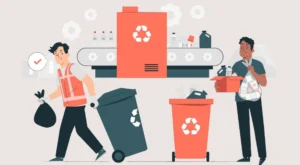Waste management is essential for protecting the environment and conserving resources. The 5 R’s of waste management—Refuse, Reduce, Reuse, Repurpose, and Recycle—provide a practical framework for managing waste and promoting sustainability. In this comprehensive guide, we will discuss about each of the 5 R’s, exploring their importance, strategies for implementation, and their impact on the environment.
Refuse: Understanding the Power of No
Refusal is the first step of effective waste management where we can reduce the generation of waste. It involves actively declining products and services that generate waste. When we say “refuse,” we mean saying no to things we don’t really need or not environment friendly.
Here are some practical ways to refuse as follows:
- Single-use plastics, such as straws, cutlery, and bags, are major contributors to environmental pollution. Instead, try to opt for reusable alternatives like stainless steel straws, cloth bags, and metal cutlery.
- Choose products with minimal or no packaging. Bring your own containers when shopping for groceries instead of asking for carry bags from stores.
- Promotional items and freebies often end up as waste. Politely decline such items unless they are genuinely useful and sustainable.
- Opt for digital versions of tickets, receipts, and documents to reduce paper waste.
By refusing unnecessary products, the volume of waste produced is minimized. Refusing single-use plastics, disposable items, and unnecessary purchases not only minimizes waste but also leads to significant cost savings over time. Encouraging businesses to adopt sustainable packaging practices and promoting eco-friendly alternatives can further contribute to waste reduction at the source.
Reduce: Minimizing Waste Production
Reduction involves minimizing the amount of waste generated by using fewer resources and creating less waste. Living a minimalist lifestyle, practicing conscious consumption, and choosing quality over quantity are key principles of waste reduction.
Here are some tips to reduce waste as follows:
- Buy only what you need to avoid excess and reduce waste. Plan your purchases and avoid impulse buying.
- Use resources efficiently to minimize waste. For example, print double-sided, use energy-saving appliances, and conserve water.
- Regularly maintain and repair items to extend their lifespan. Fixing broken items instead of replacing them reduces waste.
Reducing waste conserves natural resources, such as water, energy, and raw materials. Efficient use of resources and reduced consumption lead to financial savings. By being mindful of what we buy and how much we use, we can make a big difference.
Reuse: Extending the Life of Products
Reuse involves using items multiple times before discarding them. Instead of throwing things away, we can repair them, donate them, or find new ways to use them. This saves money, reduces waste, and helps the environment by keeping things out of the trash.
Here are some tips to reuse items as follows:
- Use glass jars, plastic containers, and cloth bags for storage and transportation.
- Purchase second-hand items such as clothing, furniture, and electronics. This not only saves money but also reduces waste.
- Donate items you no longer need to charities, shelters, or second-hand stores.
- Be creative and find new uses for old items. For example, use old t-shirts as cleaning rags or turn glass bottles into vases.
Reuse conserves resources by extending the life of products. It reduces the amount of waste sent to landfills and incinerators. Reusing items saves money by reducing the need to purchase new products.
Repurpose: Giving Second Life to Old Items
Repurpose goes beyond simple reuse and encourages transforming waste materials into new, useful products. It is all about giving old or discarded things a second life. This principle encourages innovation and resourcefulness, turning potential waste into valuable items.
Here are some tips to repurpose discarded items as follows:
- Use materials like glass jars, fabric scraps, and wooden crates for DIY projects. Create home decor, storage solutions, and garden accessories.
- Transform old furniture into new pieces. For example, turn a wooden pallet into a coffee table or an old ladder into a bookshelf.
- Use old containers, tires, and wood to create planters, compost bins, and garden beds.
- Alter old clothing to create new outfits. For example, turn old jeans into shorts or a t-shirt into a tote bag.
Repurposing diverts waste from landfills and reduces the demand for new resources. Repurposed items are unique and personalized, adding character to your home and lifestyle. By using our imagination and giving old items a new purpose, we can reduce waste and have fun being creative.
Recycle: Converting Waste into Resources
Recycle is a familiar concept that involves converting waste materials into new products through processing and manufacturing. It is all about giving waste materials a new life. Educating communities about the benefits of recycling and investing in recycling infrastructure are crucial steps towards achieving a more sustainable waste management system.
Here are some tips to help in recycling waste materials as follows:
- Sort waste into categories such as paper, plastic, glass, and metal. Proper sorting ensures efficient recycling.
- Clean recyclable items before placing them in recycling bins. Contaminated recyclables can hinder the recycling process.
- Familiarize yourself with local recycling guidelines to know what can and cannot be recycled.
- Support recycling initiatives and prefer buying products made from recycled materials to promote a circular economy.
Recycling creates jobs in collection, processing, and manufacturing, contributing to the economy. It conserves natural resources by converting waste into new materials. Recycling often requires less energy than producing new products from raw materials. It also reduces pollution by decreasing the need for raw material extraction and processing.
The Interconnectedness of the 5 R’s
The 5 R’s of waste management—Refuse, Reduce, Reuse, Repurpose, and Recycle—are interconnected principles that collectively minimize waste and promote sustainability. Refusing unnecessary items prevents waste at its source, while reducing consumption minimizes waste generation. Reusing extends product lifespans, and repurposing creatively transforms items into new, functional products. Recycling converts remaining waste into new resources. Together, these principles create a comprehensive strategy, where each action supports and enhances the others, leading to significant environmental and economic benefits. Implementing all five R’s fosters a holistic approach to waste management, ensuring a cleaner and more sustainable future.
The Impact of the 5 R’s on the Environment
By following the 5 R’s – Refuse, Reduce, Reuse, Repurpose, and Recycle – we can make a positive impact on the environment. These simple steps help us create less waste, conserve resources, and keep our planet clean and healthy. By working together and making small changes in our daily habits, we can all be waste management superheroes.
Challenges and Solutions in Implementing the 5 R’s
Implementation of the 5 R’s—Refuse, Reduce, Reuse, Repurpose, and Recycle—faces challenges such as lack of awareness and education on sustainable practices. Disposable products are often more convenient than reusable ones, making it challenging to refuse and reduce waste. Inadequate infrastructure, such as insufficient recycling facilities, hampers effective waste management. Policy and regulation gaps can also impede progress. Additionally, sustainable products can be too expensive for some people.
To overcome these challenges, we require more awareness and education on sustainable practices, supportive policies, investment in infrastructure, and community efforts. Schools, colleges, communities, and organizations can play an important role in spreading knowledge. Governments can implement policies and regulations that promote the 5 R’s, such as banning single-use plastics and incentivizing recycling. Investing in waste management infrastructure, such as recycling facilities and composting plants, can foster the waste management practices. Together we can make the 5 R’s practical and accessible for everyone.
Case Studies on Successful Waste Management Practices
When we think about the 5 R’s of waste management, it might seem like an abstract concept, something aspirational but not necessarily actionable. Yet, all around the world, there are inspiring examples of communities and organizations that have put these principles into practice with remarkable success. Let’s delve into a few case studies that highlight the transformative power of the 5 R’s.
First, let’s travel to Kamikatsu, a small town in Japan that has become a global beacon of zero-waste living. In 2003, Kamikatsu set an ambitious goal: to achieve zero waste by 2030. Fast forward to today, and over 80% of the town’s waste is recycled, reused, or composted. Residents separate their waste into 45 different categories, making it easier to ensure that materials are properly processed. This concerted community effort not only drastically reduced landfill waste but also fostered a culture of environmental responsibility and innovation. Kamikatsu proves that significant changes can be made when a community unites around a common goal. Want to know more about it? Click here.
Next, we turn to San Francisco, a city of United States known for its progressive environmental policies. In 2002, San Francisco has adopted aggressive waste management goals, aiming to become a zero-waste city. In 2018, San Francisco updated its zero waste commitments to reducing solid waste generation by 15% through comprehensive recycling and composting programs. They proposed a reduction of disposal to landfill or incineration again 50% by 2030. One key initiative is the mandatory recycling and composting ordinance, which requires all residents and businesses to separate their waste. By refusing unnecessary items and diligently reducing, reusing, repurposing, and recycling, San Francisco demonstrates that urban centres can achieve impressive waste reduction results while maintaining vibrant economies. To read the full case study, visit this page.
In the business world, Patagonia—a renowned outdoor apparel company—has set a pioneering example of corporate responsibility. Patagonia’s “Worn Wear” program encourages customers to buy fewer new products and instead invest in durable items that can be repaired and reused. It encourages customers to extend the life of their gear by repairing and reusing items instead of buying new ones. This program allows customers to trade in their gently used Patagonia gear for store credit, which can then be used to purchase other pre-loved items. The company even offers repair services and hosts events where customers can learn to fix their gear. By focusing on the reduce, reuse, and repurpose aspects of the 5 R’s, Patagonia not only minimizes waste but also fosters a loyal customer base that values sustainability.
Lastly, let’s spotlight a grassroots initiative: the Repair Café movement. Started in Amsterdam, Repair Cafés are free meeting places where people come together to repair broken items, ranging from electronics to clothing. Volunteers with repair skills guide attendees in fixing their belongings, promoting a culture of reuse and repurposing. This initiative has spread worldwide, with thousands of Repair Cafés in operation, each one diverting countless item from landfills and empowering individuals to take waste management into their own hands.
These case studies show us that the 5 R’s are not just theoretical principles but actionable steps that can lead to significant environmental and social benefits. Through concerted effort, innovative thinking, and community involvement, we can all contribute to a more sustainable future.
Conclusion
In conclusion, the 5 R’s of waste management provide a roadmap for individuals and communities to take proactive steps towards reducing waste, conserving resources, and safeguarding the environment for future generations. By implementing the principles of Refuse, Reduce, Reuse, Repurpose, and Recycle, we can collectively make a positive impact on the environment and move towards a more sustainable and eco-friendly future. Let us all work together to embrace the 5 R’s and create a cleaner, greener planet for all.













